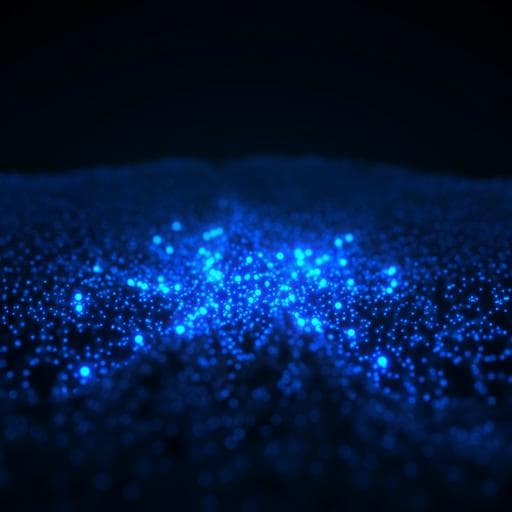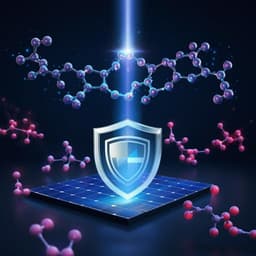
Engineering and Technology
High efficiency pure blue perovskite quantum dot light-emitting diodes based on formamidinium manipulating carrier dynamics and electron state filling
L. Gao, Y. Zhang, et al.
Discover how a new synthesis method leads to high-performance pure blue perovskite quantum dot LEDs, achieving remarkable luminance and efficiency. This groundbreaking research was conducted by Long Gao, Yilin Zhang, Lijie Gou, Qian Wang, Meng Wang, Weitao Zheng, Yinghui Wang, Hin-Lap Yip, and Jiaqi Zhang.
~3 min • Beginner • English
Introduction
Perovskite halide semiconductors offer tunable bandgaps, high carrier mobility, and long diffusion lengths, making them promising for high-efficiency light-emitting diodes (LEDs). However, achieving efficient and stable pure blue emission remains challenging because blue perovskite emitters typically suffer from high defect densities, low PLQY, and phase instability. Although mixed halide thin films (3D, 2D, quasi-2D) have reached EQEs above 10% for blue-green emission, and perovskite quantum dots (QDs) present advantages in PLQY and color purity, pure blue QD emitters still lag in performance. This work addresses the question of whether organic A-site cation doping with formamidinium (FA) can improve the optoelectronic quality, carrier dynamics, and band structure of blue-emitting CsPb(Cl/Br)₃ QDs synthesized at room temperature, thereby enabling high-efficiency pure blue QD LEDs. The study proposes FA cation incorporation (via formamidine acetate precursor) to modulate crystal growth, reduce defects, manipulate carrier injection barriers, and tailor band-edge states. The authors demonstrate substantial PLQY enhancement and improved device metrics, highlighting the importance of room-temperature processing for scalable synthesis and practical application.
Literature Review
Early QD-based PeLEDs using Br/Cl-mixed perovskites achieved limited blue performance (EQE ~0.07%). Subsequent strategies focused on ion doping to alter energy structures, including divalent (Mn²⁺, Sn²⁺, Cd²⁺, Zn²⁺, Cu²⁺) and trivalent lanthanide dopants at the B-site. Notably, Ni²⁺-doped CsPbX₃ (470 nm) reached EQE 2.4%, and multiple-cation A/B-site doping in CsPb(BrₓCl₃₋ₓ) improved PLQY and achieved EQE 2.14% in blue QD LEDs. Acid-etching of small all-bromide QDs reduced vacancy defects, yielding EQE 4.7%. For thin films, multi-quantum-well and multi-cation architectures enhanced exciton stability and energy transfer, with best EQEs reported at 11.7% (488 nm) and 13.8% (496 nm). Beyond inorganic cations, organic A-site doping can improve thermal, moisture, and chemical stability; FA cations can tune the tolerance factor toward 1 to improve structural stability and suppress ion migration. Nonetheless, high-performance FA-doped pure blue QDs, particularly via room-temperature synthesis suitable for scale-up, remain underexplored.
Methodology
Synthesis: Pure blue perovskite QDs of nominal composition FA-CsPb(Cl₀.₅Br₀.₅)₃ were synthesized at room temperature via a ligand-assisted reprecipitation (LARP) method. Formamidine acetate (FAAc) was introduced as an FA cation precursor with varying feeding ratios (0, 0.05, 0.1, 0.15, 0.2 M; additional FA-only samples also studied). The approach enables partial substitution of Cs⁺ by FA⁺ in the A-site lattice positions, modulating crystal growth, grain size, and defect density.
Characterization: Morphology and crystal structure were examined by TEM/HRTEM (grain size distribution; lattice fringe analysis) and XRD. FTIR verified incorporation of FA via characteristic C=N and N–H vibrations. XPS surveyed surface composition and chemical states (N 1s, Cs 3d, Pb 4f, Br 3d, Cl 2p) to confirm partial A-site substitution and probing binding energy shifts. Optical properties included UV–vis absorption, steady-state PL, absolute PLQY, and time-resolved PL (TRPL) with biexponential fitting to extract average lifetimes across FA contents. Femtosecond transient absorption spectroscopy (TAS) under 400 nm excitation probed carrier dynamics, tracking photoinduced bleach (PB) and photoinduced absorption (PA), hot-carrier relaxation, and bandgap renormalization. Band structure was analyzed via Tauc plots to estimate optical bandgaps. First-principles (DFT) calculations, as noted, were used to elucidate FA cation effects on electronic structure and density of states. Device fabrication: Blue QD LEDs were fabricated using the optimized FA-doped QDs as emitters; electroluminescence (EL), luminance, EQE, and operational stability (T₅₀) were measured. Specific layer stack details are not provided in the excerpt, but performance metrics and EL peak wavelength/CIE coordinates are reported.
Key Findings
− FA cation incorporation via FAAc at room temperature substantially enhances blue QD emitter quality. The optimized FA-CsPb(Cl₀.₅Br₀.₅)₃ QDs achieve PLQY of 65%, approximately sixfold higher than undoped (~10%).
− Optical spectra: Absorption excitonic peak red-shifts from 440 nm (pristine) to 458 nm with FA doping, and to 478 nm for FA-only emitters; PL peak shifts from 456 nm to 473 nm with FA content, reaching 498 nm for FAPb(Cl₀.₅Br₀.₅)₃.
− Size vs. bandgap: TEM shows particle sizes change from ~10 ± 0.3 nm (pristine) to ~12 ± 0.4 nm (0.2 M FA). Quantum confinement calculations indicate only ~16 meV bandgap shift expected from size change, far less than the observed ~110 meV, implicating electronic structure modification by FA.
− TRPL: Average lifetimes increase with FA content, indicating reduced nonradiative recombination and lower defect density: 137.8 ns (0 M), 154.6 ns (0.05 M), 183.4 ns (0.1 M), 201.0 ns (0.15 M), 214.4 ns (0.2 M).
− Crystal structure: XRD shows cubic CsPb(Br/Cl)₃ phase with diffraction peaks shifting to lower angles upon FA incorporation, evidencing lattice expansion (substitution of smaller Cs⁺ (1.81 Å) by larger FA⁺ (2.79 Å)). The (200) peak shifts by ~0.36°, and preferred orientation along (100) is enhanced. HRTEM interplanar spacing for (200) increases from 2.60 Å (undoped) to 2.71 Å (0.2 M FA).
− Chemical analysis: FTIR reveals FA signatures (C=N at 1716 cm⁻¹, broad N–H 3300–3500 cm⁻¹) increasing with FA content. XPS N 1s peak at 399.8 eV confirms FA; minor N 1s at 401.8 eV indicates trace DDA⁺ ligands. Pb 4f peaks shift by +0.3 eV (higher binding energy) in FA-doped samples, consistent with stronger Pb–halide binding and reduced octahedral volume; Cs 3d, Br 3d, and Cl 2p show no notable shifts.
− Carrier dynamics (TAS, 400 nm excitation): FA-doped QDs exhibit stable PB with slower recovery and negligible PA features, indicating faster hot-carrier cooling and reduced hot-carrier absorption relative to undoped. The PB–PA energy separation decreases from ~100 meV (undoped) to ~50 meV (0.2 M FA), attributed to bandgap renormalization. Bleach recovery kinetics show suppression of ultrafast trap-assisted nonradiative pathways and enhancement of excitonic radiative recombination.
− Bandgap: Tauc analysis gives E_g ≈ 2.72 eV for CsPb(Cl₀.₅Br₀.₅)₃ (undoped), consistent with absorption features; FA doping adjusts band-edge states beyond size effects.
− Device performance: Pure blue FA-CsPb(Cl₀.₅Br₀.₅)₃ QD LEDs show EL peak at 474 nm with CIE (0.113, 0.101), maximum luminance 1452 cd m⁻², and external quantum efficiency (EQE) 5.01%. Operational stability shows T₅₀ of 1056 s at an initial luminance of 100 cd m⁻².
− Mechanistic insights: FA doping reduces defects and nonradiative recombination, enhances exciton binding and radiative pathways, accelerates hot-carrier relaxation, and modulates the band structure/density of states to facilitate charge injection.
Discussion
The study addresses the central challenge of achieving efficient, stable pure blue emission from perovskite QDs by introducing FA cations at the A-site to manipulate lattice structure and electronic states. FA incorporation expands the lattice and corrects octahedral distortions, reducing defect density and suppressing nonradiative decay channels, as evidenced by increased PLQY and prolonged TRPL lifetimes. Spectroscopic analyses (FTIR, XPS) verify FA doping and stronger Pb–halide interactions, contributing to improved structural stability. TAS reveals accelerated hot-carrier cooling and reduced PA signals, indicating less energy loss before radiative recombination and a reduced PB–PA separation consistent with bandgap renormalization. The discrepancy between observed bandgap shifts and those predicted by quantum confinement alone demonstrates that FA cations directly modify band-edge states and density of states, improving carrier injection and excitonic emission. These combined effects culminate in high device performance (EL at 474 nm, EQE 5.01%, luminance 1452 cd m⁻²) and reasonable operational stability, showing that room-temperature FA doping is an effective pathway to high-quality pure blue QD emitters and LEDs.
Conclusion
This work demonstrates a simple, room-temperature FA cation doping strategy to produce high-quality pure blue perovskite QDs, achieving PLQY up to 65% and enabling QD LEDs with EL at 474 nm, EQE of 5.01%, and luminance of 1452 cd m⁻². Structural and spectroscopic analyses confirm FA incorporation, lattice expansion, defect reduction, and stronger Pb–halide interactions. Carrier dynamics studies reveal faster hot-carrier relaxation and enhanced radiative recombination, while band structure analyses indicate FA-induced modification of band-edge states beyond quantum confinement effects. The approach offers a feasible and scalable route to improve blue perovskite QD emitters and device performance.
Potential future directions include: optimizing FA incorporation levels and precursor chemistries to further suppress defects and aggregation; integrating complementary surface passivation and ligand engineering to enhance stability and charge injection; exploring device stack engineering for improved operational lifetime; and extending the strategy to other mixed-halide compositions for deeper blue emission while maintaining high efficiency and stability.
Limitations
Excessive FA incorporation (beyond ~0.2 M FAAc in the precursor) leads to the formation of new defects and QD agglomeration due to excess acid, causing a decrease in PLQY. While device stability is improved relative to undoped systems, the reported T50 (1056 s at 100 cd m⁻²) indicates room for further lifetime enhancement. Detailed device architecture and long-term environmental stability data are not provided in the excerpt.
Related Publications
Explore these studies to deepen your understanding of the subject.







